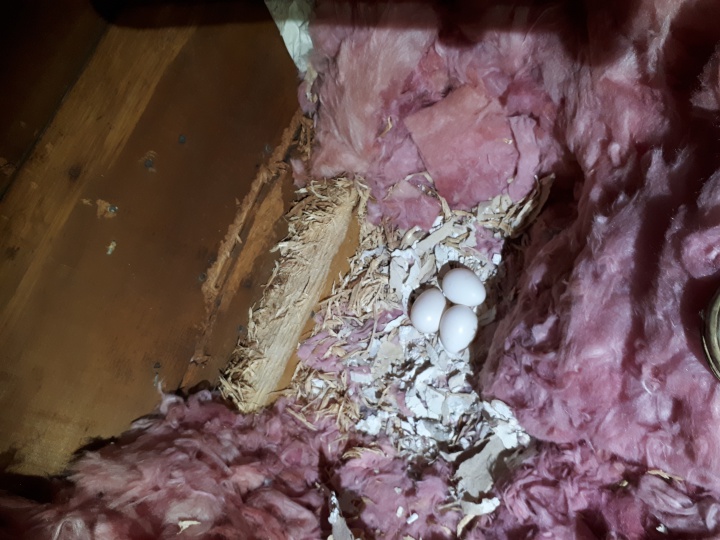Kākā intruders on the increase
8 October 2018

Flat hunting season in Wellington usually starts with the students in February. However, this year kākā breeding activity is bringing a wave of unwanted intruders into Wellington properties.
Department of Conservation rangers have responded to several requests to help evict unwanted tenants from roof spaces as the native parrots seek to nest in handy cavities. With strong beaks and a very inquisitive nature, kākā can make their way into ceilings, mistaking them for their natural nest sites inside rotten trees.
DOC biodiversity ranger David Moss crawled inside a tight roof space to relocate a nest of three eggs last week, and was called out to attend another potential home invasion recently.
“We usually get a few calls this time of year about strange noises at strange times. Where the birds have managed to get inside, its best for both them and their human landlords if we carefully relocate them.”
Purpose-built kākā nesting boxes are usually fixed in a nearby location, and the eggs or chicks are carefully transferred. The new location is observed to check the adult birds have found their brood.
“Kākā are pretty good parents. They hang around not too far away while we do the operation and eye us suspiciously. But once we leave them to it, they seem pretty happy with the upgrade.”
Damage to property is only one risk. By nesting in ceilings, kākā put themselves in contact with potentially harmful materials such as glass wool insulation, treated timbers, and lead nails and plumbing which they chew.
“Lead poisoning is a leading cause of death for Wellington kākā, along with metabolic bone disease caused by being fed inappropriate food by people.
“A good way to avoid kākā moving in with you is not to encourage them to hang around the property by feeding them. Spending time around buildings waiting to be fed also increases the chance they’ll mess about with lead nails or other toxic products.”
David Moss also recommends checking your roof for any weak points such as vents or rotten wood where kākā could break in. He recommends placing well-secured steel plates or mesh over these sites.
When kākā chicks leave their nest, after around 70 days, they are generally unable to fly. Being grounded for several days makes them vulnerable to cats, dogs and other predators which can be more common around people’s homes.
“If you already have a rat trap, add a stoat trap or possum trap to your backyard. Until we can fulfil the predator free vision for all of Wellington, its best if we send these birds the signal that they stick to safe, natural nesting sites.”
Anyone suspecting they have kākā nesting in their home can call DOC for advice on 0800 362 468.
Background
information
Kākā were re-introduced to Wellington
between 2002 and 2006 when fourteen captive birds from zoos
were released into ZEALANDIA sanctuary. By early 2018, over
920 kākā had been banded and more and more un-banded
kākā are now showing up at official feeding sites,
indicating that kākā are now also breeding in natural nest
sites both inside and outside of ZEALANDIA.
https://www.doc.govt.nz/nature/native-animals/birds/birds-a-z/kākā/
–Ends–


 Gordon Campbell: On Marketing The Military Threat Posed By China
Gordon Campbell: On Marketing The Military Threat Posed By China The New Zealand Remembrance Army: Victoria Cross And Hardham Cup Come Together For First Time In Over 100-years
The New Zealand Remembrance Army: Victoria Cross And Hardham Cup Come Together For First Time In Over 100-years RNZ Online: How The World Reacted To The Demise Of The Treaty Principles Bill
RNZ Online: How The World Reacted To The Demise Of The Treaty Principles Bill Te Matapihi: Response To Govt’s New Strategic Housing Partnerships: Progress, But Equity Gaps Remain
Te Matapihi: Response To Govt’s New Strategic Housing Partnerships: Progress, But Equity Gaps Remain Banking Class Action: Government’s Retrospective Law Change Threatens Consumer Protections
Banking Class Action: Government’s Retrospective Law Change Threatens Consumer Protections E tū: Journalists Respond To Grenon - Still No Commitment To Editorial Independence
E tū: Journalists Respond To Grenon - Still No Commitment To Editorial Independence Marlborough District Council: Kevin Judd Named Marlborough’s Newest Living Cultural Treasure
Marlborough District Council: Kevin Judd Named Marlborough’s Newest Living Cultural Treasure


